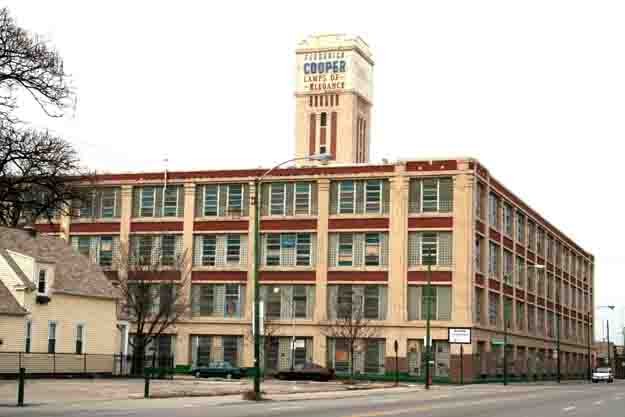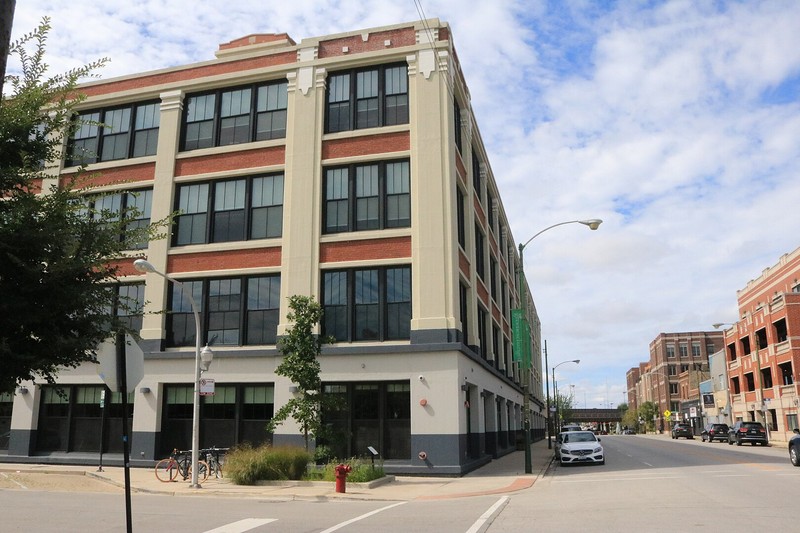Vassar Swiss Underwear Company Building
Introduction
Text-to-speech Audio
Construction on The Vassar Swiss Underwear Company Building, also known historically as the Cooper Lamp Building, finished in 1914. The form-fitting union suit, born out of women's reform movements, became popular during the late nineteenth century, notably when the trend shifted from women's union suits to a male version. Chicago native George E. Rutledge experimented with the design (of the male version) to make it more comfortable and improve production equipment to make it cheaper. In 1900, Rutledge obtained a patent for his new union suit, and he partnered with Emil A. Basener and Frederick S. McCoy to form the Vassar Swiss Underwear Company. In 1912, the trio sold the company to the Northwestern Knitting Company, who moved the operation into the now-historic property on Diversy near the rail lines adjacent to the Maplewood Station. The building survives as a reminder of how Chicago's Logan Square neighborhood once supported an abundance of successful manufacturing operations.
Images
Vassar Swiss Underwear Company Building, 1914

Cooper Lamps (Vassar Swiss Underwear Company Building), 1990s

Green Exchange (Vassar Swiss Underwear Company Building), 2018

Green Exchange (Vassar Swiss Underwear Company Building), 2020s.

Backstory and Context
Text-to-speech Audio
The union suit arose as part of nineteenth-century dress reform movements that ostensibly attempted to free women from having to wear painful corsets, heavy bustles, and long skirts often riddled with germs from scraping the ground. (The entire scope of the nineteenth-century women's movements and its ties to dress reforms goes beyond the scope of this entry, but links below will provide expanded information on the subject). The first union suit patent emerged just after the Civil War in 1868, but only ardent feminists chose to embrace the new fashion choice. Indeed, one union suit advocate was Mary Walker, a women's rights activist and the only female surgeon during the Civil War (the first and only woman awarded the Medal of Honor), was occasionally arrested for wearing trousers and suspenders. By the late 1800s, the union suit finally (albeit slowly) gained acceptance, notably in New England. In 1875, Susan Taylor Converse from Massachusetts patented an upgraded undergarment version of the union suit. However, before long, men's versions emerged, which, by the turn of the twentieth century, overtook the women's version as the staple; the union suit industry became almost an entirely male-orientated business by 1910.
George E. Rutledge of Chicago decided to redesign the male union suit to make it more durable and comfortable, as well as cheaper to produce. In 1900, he obtained a patent for his improved union suit, designed improved production equipment, and partnered with Emil A. Basener and Frederick S. McCoy to form the Vassar Swiss Underwear Company. The trio moved the company to rural Rochelle, Illinois, in 1903 but sold the company in 1912 to Northwestern Knitting Company, who subsequently moved the operation back to Chicago; Rutledge and his partners continued to manage the business. Northwest Knitting built a new plant to house the Vassar Swiss Company in Chicago's Logan Square neighborhood next to the city rail lines near the Maplewood station. The now-historic factory opened in 1914, and Vassar Swiss prospered in its new home.
Rutledge retired in 1937, not long before the union suit's popularity waned. By the mid-twentieth century, the company shifted its emphasis to briefs and shortened its name to "Vassar Company" and, in 1951, "Vassarette." In 1967, the company vacated the historic building and moved its operations to Paris, Texas. The Frederick Cooper Lamp Company, a high-end lamp manufacturer, purchased the building. Cooper Lamp remained in the building until 2005. Baum Development acquired the building in 2006 and subsequently renovated it, transforming it into an office building catering to environmentally friendly businesses known as "The Green Exchange," which remains its purpose as of 2023.
Sources
The Commission on Chicago Landmarks. "Landmark Designation Report: Vassar Swiss Underwear Company Building." City of Chicago Department of Planning and Development. February 7, 2008. https://www.chicago.gov/content/dam/city/depts/zlup/Historic_Preservation/Publications/Vassar_Swiss_Underwear_Co_Bldg.pdf.
Kenny, Jennifer and Victoria Granacki. "Registration Form: Vassar Swiss Underwear Company Building." National Register of Historic Places. archives.gov. 2007. https://catalog.archives.gov/id/28892424.
Kesselman, Amy. "The 'Freedom Suit': Feminism and Dress Reform in the United States, 1848-1875." Gender and Society 5, no. 4 (1991): 495–510.
Komar, Marlen. "How 19th-Century Activists Ditched Corsets for One-Piece Long Underwear." Smithsonian Magazine. smithsonianmag.com. January 19, 2021. https://www.smithsonianmag.com/innovation/how-19th-century-activists-ditched-corsets-for-one-piece-long-underwear-180976774/.
Komski, Elizabeth A., "Fashion's Foes: Dress Reform from 1850-1900" Masters Thesis. William & Mary, 2001. https://dx.doi.org/doi:10.21220/s2-cmdg-dr92.
Mas, Catherine. "She Wears the Pants: The Reform Dress as Technology in Nineteenth-Century America." Technology and Culture 58, no. 1 (2017): 35–66. http://www.jstor.org/stable/26406095.
By Vassar Swiss Co - Vassar Swiss Co, Public Domain, https://commons.wikimedia.org/w/index.php?curid=11222094
https://webapps1.chicago.gov/landmarksweb/web/landmarkdetails.htm?lanId=12964
By Anthony Dirico - Own work, CC BY-SA 4.0, https://commons.wikimedia.org/w/index.php?curid=72709093
Green Exchange: https://www.greenexchange.com/gallery
